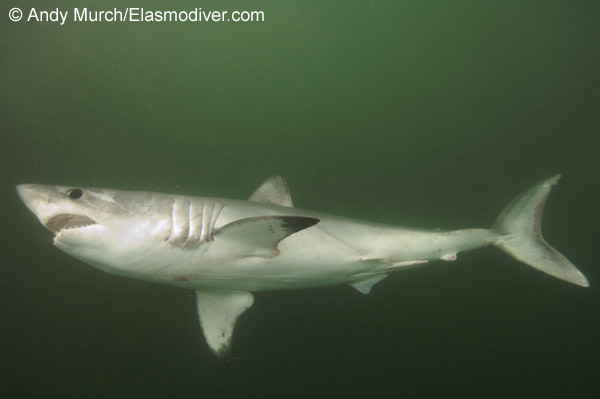| Lamnidae (Mackerel sharks or white shark) |
| 350 cm TL (male/unsexed); max.weight: 230 kg; max. reported age: 30 years |
|
pelagic-oceanic; depth range 0 - 715 m, oceanodromous |
| Circumglobal, amphitemperature with centers of distribution in the North Atlantic and temperate water of the southern hemisphere; not in equatorial seas. Appendix III (Mediterranean) of the Bern Convention (2002). Appendix II of the Bonn Convention (2009). |
|
Dorsal spines (total): 0-0; Dorsal soft rays (total): 0-0; Anal spines: 0-0; Anal soft rays: 0-0. A stout, spindle-shaped shark with large black eyes, a sharp, conical snout, long gill slits, and small, smooth-edged, narrow teeth with side cusps (Ref. 5578, 88171). Strong keels on the caudal peduncle, short secondary keels on the caudal base, and a crescentic caudal fin; the insertion of the small second dorsal fin is above the insertion of the anal fin (Ref. 88171). Dark grey dorsally, white ventrally, without blotches (Ref. 6581, 43278); rear tip of 1st dorsal abruptly white (Ref. 5578). |
| Most abundant on continental offshore fishing banks but also found far from land in ocean basins and occasionally close inshore (Ref. 247). Pelagic, epipelagic or littoral shark. Highly migratory, moves generally along the continental shelves. Specimens tagged off southern England were recaptured in northern Norway (having travelled 2,370 km), Denmark and Spain (Ref. 88752, 88753). The northwest Atlantic stock migrates from Newfoundland, Canada in the winter to Massachusetts in the summer (Ref. 43278, 88754). Trans-Atlantic migrations have also been recorded. One of the most cold-tolerant sharks; in the northwest Atlantic mostly found from 5-10°C (Ref. 88755). Known to temporarily tolerate salinities as low as 10 to follow its prey (Ref. 88740). Found singly and in schools and feeding aggregations (Ref. 247). Feeds on small and medium-sized pelagic schooling species, other sharks, squid (Ref. 5578) and demersal fishes (cod, white hake, red hake, haddock and cusk (Ref. 5951, 43278)). Ovoviviparous species (Ref. 43278, 50449). Females grow larger than males (Ref. 88756). Catch records and studies in the northeast Atlantic show segregation by sex and size (Ref. 56108, 88756, 88757). Parasites include Phyllobothrium dagnallium (found in stomach, intestine and spiral valve) and Dinobothrium sp. (Ref. 5951). Regarded as potentially dangerous to people because of its size and activity but has never or very seldom been indicted in an attack on people or boats (Ref. 247). Excellent sportfish (Ref. 84357). The flesh of the porbeagle is of good quality and texture and is said to taste like swordfish (Ref. 84357). Utilized fresh, dried or salted and frozen for human consumption; for oil and fishmeal; fins for shark-fin soup (Ref. 247). May be pan-fried and broiled (Ref. 9988). |
|
Vulnerable (A2bd+3d+4bd)
(Ref. 96402)
|
| traumatogenic |
|
Source and more info: www.fishbase.org. For personal, classroom, and other internal use only. Not for publication.
Page created by Jen, 05.08.02,
php script by kbanasihan 06/09/2010 ,
last modified by
dsantos, 20/08/10

